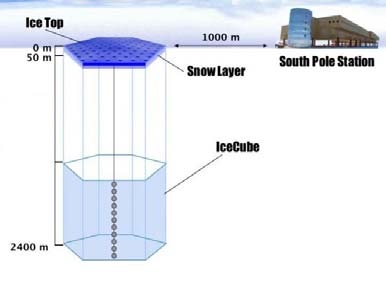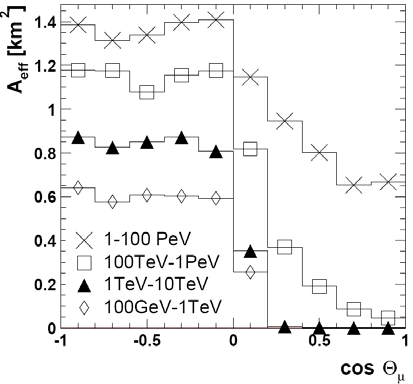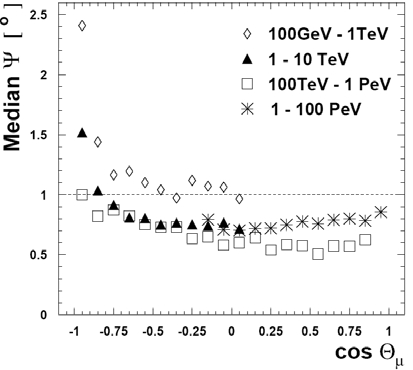THE ICECUBE NEUTRINO OBSERVATORY
O. Botner for the IceCube Collaboration*
Division of High Energy Physics, Uppsala university, Box 535, SE – 75121 Uppsala, Sweden
IceCube is a kilometer-scale deep-ice neutrino observatory under construction at the South Pole. This
paper presents a brief overview of the IceCube concept and components, its science goals, the expected
performance and the present status of the project.
1. INTRODUCTION
The prime objective for the IceCube neutrino
telescope [1] is the discovery of ultra-high
energy cosmic neutrinos considered a promising
tool for further exploration of the universe. Such
observations would be expected to shed light on
the mechanisms of acceleration of the highest
energy cosmic rays and allow a mapping of their
sources. They might also provide essential
insights regarding the origin of the observed
high-energy
γ
rays. Neutrino production requires
hadronic processes for which two scenarios are
implied in the literature [2]: in the top-down
models neutrinos arise as decay products of
massive (M ~ 10
23
eV) cosmological remnants;
in the bottom-up models neutrinos originate in
decays of pions which are produced when
charged particles, accelerated to ultra-high
energies by ”cosmic accelerators” driven by
gravitational energy release, interact with dense
clouds of radiation or matter surrounding the
source. The possible ”accelerators” include
Active Galactic Nuclei (AGN), microquasars,
supernova remnants (SNR) and colliding neutron
stars or black holes (GRB). Hence, search for
steady, variable or transient sources of high-
energy neutrinos is an important science goal for
IceCube.
Apart from the astrophysics objectives, IceCube
plans to investigate topics related to particle
physics, such as signatures of dark matter or
extra dimensions, and to search for magnetic
monopoles and exotic superheavy objects like
____________________
* reference to full author list at the end
nuclearites or Q-balls [2]. In addition, owing to
the low dark noise rate of the optical modules
(OM) in ice (< 1 kHz), IceCube will be sensitive
to a coherent OM rate increase due to MeV
neutrinos from potential SN explosions within
our galaxy. IceCube will participate in the SN
alert network SNEWS [3].
2. THE ICECUBE CONCEPT
The conceptual design of IceCube is shown in
figure 1. IceCube is an array of 80 strings – in
total 4800 OMs – deployed in a hexagonal
pattern over an area of ~ 1 km
2
.
Figure1. IceCube and IceTop
The OMs are connected to the strings at depths
between 1400 and 2400 m where the optical
properties of the ice are well understood owing
to measurements with the AMANDA set-up [4].
The distance between strings, 125 m, and the
distance between OM’s in a string of about 17 m,
is a result of an optimization for the principal
energy range (TeV- PeV) of interest to IceCube
[5].
The deep-ice detector is complemented by an
Extensive Air Shower array on the surface –
IceTop – consisting of 2 frozen water tanks with
2 OM’s each on top of every string. In total 320
modules. The combination of IceCube with a
surface array provides a unique possibility of
tagging muons produced by cosmic rays in the
atmosphere which penetrate to the deep-ice
array. A valuable aspect is that the IceCube OMs
can be surveyed and calibrated
in situ
. Also
important is the possibility of vetoing some
“background”
events
originating
in
the
atmosphere. All events with E > 300 TeV can be
vetoed when the shower passes the surface array.
The geometrical reach of the veto increases with
increasing
shower
energy.
In
addition
IceTop/IceCube may be used for cosmic ray
studies. IceTop has full efficiency in an energy
range < 10
15
– 10
18
eV. This includes the “knee”
of the cosmic-ray spectrum around 3.10
15
eV as
well as the likely beginning of the transition from
galactic to extra-galactic cosmic rays above
10
17
eV.
The fundamental component of IceCube is the
Digital Optical Module, DOM, figure 2. Each
DOM is a self-contained “mini” data acquisition
system (DAQ) capable of recording signals from
an optical sensor, digitizing and storing these
with minimal loss of information and
transmitting them to the surface at request. The
optical sensor is a 10 inch diameter, 10 stage
Hamamatsu R-7081 PMT coupled via an UV
transparent optical gel to the glass pressure
housing enclosing both the sensor and the
electronics. The housing is designed to withstand
a pressure of at least 600 bar.
The DOM digitizes the PMT waveform ensuring
a dynamic range of 200 photoelectrons (p.e.)
within the first 15 ns, a total of 2000 p.e. within 5
µs
and a dead time < 1%. Each waveform is
time-stamped locally, allowing to achieve a
relative timing accuracy between modules of
σ
~ 7 ns, making this contribution to the
reconstruction efficiency for neutrinos small
relative to the effects of light scattering. The
Figure 2.
Schematics of a Digital Optical
Module showing the PMT, the three electronics
boards and the mu-metal shield enclosed in the
pressure sphere.
basic performance of the IceCube design has
been verified with the AMANDA string 18
deployed at the South Pole in January 2000,
comprising 40 prototype digital optical modules
connected both to the standard AMANDA DAQ
and to a prototype digital DAQ. Waveforms have
been recorded and analyzed, and down going
muons detected. Also, the critical aspects of time
stamping have been verified.
3. PHYSICS PERFORMANCE
IceCube will be sensitive to all neutrino flavors
over a large energy range. Muon tracks from
ν
µ
can be reconstructed above 10
11
eV. Cascades
from
ν
e
or
ν
τ
can be reconstructed from 10
13
eV
and v
τ
can be identified above 10
15
eV. IceCube
performance for muons at TeV – PeV energies
has been investigated in detail in [6] whereas its
performance at EeV energies has been studied in
[7].
Figure 3 (top) shows the effective area for
neutrino-induced muons as a function of the
zenith angle for 4 different muon energy ranges.
A generic E
–2
ν
µ
spectrum has been assumed and
cuts have been applied to ensure track quality
and suppress the down going atmospheric muon
background by a factor of 10
6
. An effective area
of 1 km
2
will be achieved for upward-moving
muons in the tens of TeV range. The sensitive
aperture of the array increases with increasing
energy and in the PeV range full sky
observations become possible.
Figure 3 (bottom) shows the pointing resolution
(median space angle error) for muons originating
from
ν
µ
‘s as a function of the zenith angle, after
application of background suppression cuts.
Figure 3. Effective area for muons originating
from neutrinos as a function of zenith angle
(top). Pointing resolution (median space angle
error) for neutrino-induced muons as a function
of zenith angle (bottom).
The
resolution
improves
with
energy,
approaching 0.6º at the horizon for muons with
energies of the order tens of TeV.
Figure 4 shows the sensitivity of IceCube for
diffuse fluxes of astrophysical neutrinos.
Assuming a generic diffuse E
–2
ν
µ
spectrum and
optimizing the cuts for best sensitivity we obtain
a 90% C.L. exclusion limit of 4.2 . 10
-9
cm
–2
s
–1
sr
–1
GeV (horizontal full line) for 3 years of data
taking. The second full line shows the
corresponding limit for a generic E
–1
ν
µ
spectrum. The limits have been evaluated
assuming the recombination quark-parton model
for the charm contribution [8]. Other models for
charm [9] would result in improved limits. The
dashed (dotted) line in figure 4 indicates the
expected diffuse
ν
flux from a model of photo-
hadronic interaction in AGN cores (jets) [10, 11].
The model rejection factors (
mrf
) indicate a
sensitivity of
mrf
.
Φ
at 90% C.L. for a model
predicting a flux
Φ
after 3 years of data taking.
Figure 4. Expected sensitivity of IceCube (3
years of data taking) to a diffuse flux of
neutrinos assuming a E
–2
spectrum.
A considerable improvement of the overall
sensitivity for diffuse sources is expected when
exploiting IceCube capability to detect cascades
from
ν
e
or
ν
τ
. An effective volume of ~ 1 km
3
will be achieved for cascades above 10 TeV.
Possible powerful sources of high-energy
neutrinos like AGN’s will be searched for by
looking for an excess of events from within a
limited region of the sky. An expected angular
resolution in the sub-degree range will allow
IceCube to restrict the search window, thereby
reducing the background, while loosening other
cuts to retain a larger fraction of the signal.
Optimizing the cuts for best sensitivity we obtain
a 90% C.L. exclusion limit of 2.4 . 10
-9
cm
–2
s
–1
GeV for 3 years of data taking.
Figure 4 also shows (dash-dotted) the prediction
from the GRB model by [12]. Assuming
independently available spatial and temporal
information, IceCube expects after 1 year of data
taking to achieve a sensitivity at the level of 20%
of the flux predicted by this model.
4. DRILLING AND DEPLOYMENT
The IceCube strings will be deployed in 60 cm
diameter holes drilled in the South Pole glacier
utilizing water at 80
°C
. The Enhanced Hot
Water Drill (EHWD) represents a development
of the drill technology used in the case of
AMANDA, making it possible to drill a vertical
hole to a depth of 2450 m within ~ 40 hours. Up
to 18 holes per season are foreseen. Mounting,
testing and lowering of a string with 60 DOMs is
expected to take about 20 hours. All drill
components have been dispatched to the South
Pole, to be used for the first time during the
2004/2005 campaign.
Figure 5. The hose-reel for the IceCube Hot
Water Drill assembled at the South Pole, January
2004.
5. STATUS OF THE ICECUBE PROJECT
AND CONSTRUCTION.
The IceCube collaboration includes about 150
researchers from 26 institutions in Belgium,
Germany, Japan, the Netherlands, New Zealand,
Sweden, U.K., USA and Venezuela. The funding
in the US is provided by the NSF, since 2004
through an MRE grant. Significant funding has
also been granted in Germany, Belgium and
Sweden. After an initial start-up phase, it is now
foreseen to deploy the very first IceCube strings
in January 2005.
The initial IceCube strings will be positioned in a
pattern close to the AMANDA array, to provide
both the possibility of calibration of IceCube
with well-defined muon tracks and, more
importantly, to ensure continuous science output
during IceCube construction. Finally, AMANDA
will become a fully integrated low threshold sub-
array within IceCube. Construction of IceCube
should be completed in January 2010.
REFERENCES
1. http://icecube.wisc.edu
2. J.G. Learned and K. Mannheim, Annu. Rev.
Nucl. Part. Sci. 2000.50:679
3. http://cyclo.mit.edu/snnet
4. J. Ahrens et al., Phys. Rev. D66 (2002)
012005
5. M. Leuthold, Proc. Workshop on Large
Neutrino Telescopes, Zeuthen 1998
6. J. Ahrens et al., Astropart. Phys. 20 (2004)
507
7. S. Yoshida, R. Ishibashi, H. Miyamoto, Phys.
Rev. D69 (2004) 103004
8. E.V. Bugaev et al., Phys. Rev D58 (1998)
054001
9. M. Thunman, G. Ingelman, P. Gondolo,
Astropart. Phys. 5 (1996) 309
10. F.W. Stecker and M.H. Salamon, Space Sci.
Rev. 75 (1996) 341
11. K. Mannheim, R. Protheroe, J. Rachen,
Phys.Rev. D63 (2001) 023003
12. E. Waxman and J. Bahcall, Phys. Rev. D59
(1999) 023002
ICECUBE AUTHOR LIST
http:
//icecube.wisc.edu/pub_and_doc/conferences/



